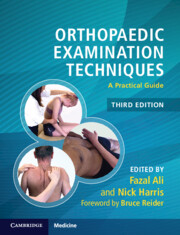Book contents
- Orthopaedic Examination Techniques
- Orthopaedic Examination Techniques
- Copyright page
- Dedication
- Contents
- Contributors
- Preface to 3rd edition
- Foreword to 2nd edition
- Foreword to 3rd edition
- Acknowledgements
- About the authors
- Chapter 1 General Principles of Orthopaedic Clinical Examination
- Chapter 2 Examination of the Shoulder
- Chapter 3 Examination of the Elbow
- Chapter 4 Examination of the Wrist
- Chapter 5 Examination of the Hand
- Chapter 6 Examination of the Peripheral Nerves in the Hand and Upper Limb
- Chapter 7 Examination of the Adult Spine
- Chapter 8 Examination of the Hip
- Chapter 9 Examination of the Knee
- Chapter 10 Examination of the Foot and Ankle
- Chapter 11 Examination of the Brachial Plexus
- Chapter 12 Orthopaedic Examination Techniques in Children
- Chapter 13 Examination of the Spine in Childhood
- Chapter 14 Paediatric Clinical Cases
- Chapter 15 Spine Clinical Cases
- Chapter 16 Upper Limb Clinical Cases
- Chapter 17 Lower Limb Clinical Cases
- Chapter 18 Orthopaedic Cases in the Developing World
- Index
- References
Chapter 9 - Examination of the Knee
Published online by Cambridge University Press: 22 April 2022
- Orthopaedic Examination Techniques
- Orthopaedic Examination Techniques
- Copyright page
- Dedication
- Contents
- Contributors
- Preface to 3rd edition
- Foreword to 2nd edition
- Foreword to 3rd edition
- Acknowledgements
- About the authors
- Chapter 1 General Principles of Orthopaedic Clinical Examination
- Chapter 2 Examination of the Shoulder
- Chapter 3 Examination of the Elbow
- Chapter 4 Examination of the Wrist
- Chapter 5 Examination of the Hand
- Chapter 6 Examination of the Peripheral Nerves in the Hand and Upper Limb
- Chapter 7 Examination of the Adult Spine
- Chapter 8 Examination of the Hip
- Chapter 9 Examination of the Knee
- Chapter 10 Examination of the Foot and Ankle
- Chapter 11 Examination of the Brachial Plexus
- Chapter 12 Orthopaedic Examination Techniques in Children
- Chapter 13 Examination of the Spine in Childhood
- Chapter 14 Paediatric Clinical Cases
- Chapter 15 Spine Clinical Cases
- Chapter 16 Upper Limb Clinical Cases
- Chapter 17 Lower Limb Clinical Cases
- Chapter 18 Orthopaedic Cases in the Developing World
- Index
- References
Summary
Examination of the knee joint begins with standing the patient, then asking them to walk. Look for any lurch and observe the foot and patella progression angles. Next ask the patient to sit with their legs hanging over the couch. Observe the patella height and tracking. Then palpate for an effusion and for areas of tenderness. After this, examine the cruciate and collateral ligaments. Depending on the findings, so far further special tests would be a dial test for the posterolateral corner, meniscal stimulation tests or patellofemoral tests. Included in the chapter is clinical evaluation of the acutely injured knee in the child.
Keywords
- Type
- Chapter
- Information
- Orthopaedic Examination TechniquesA Practical Guide, pp. 153 - 171Publisher: Cambridge University PressPrint publication year: 2022

